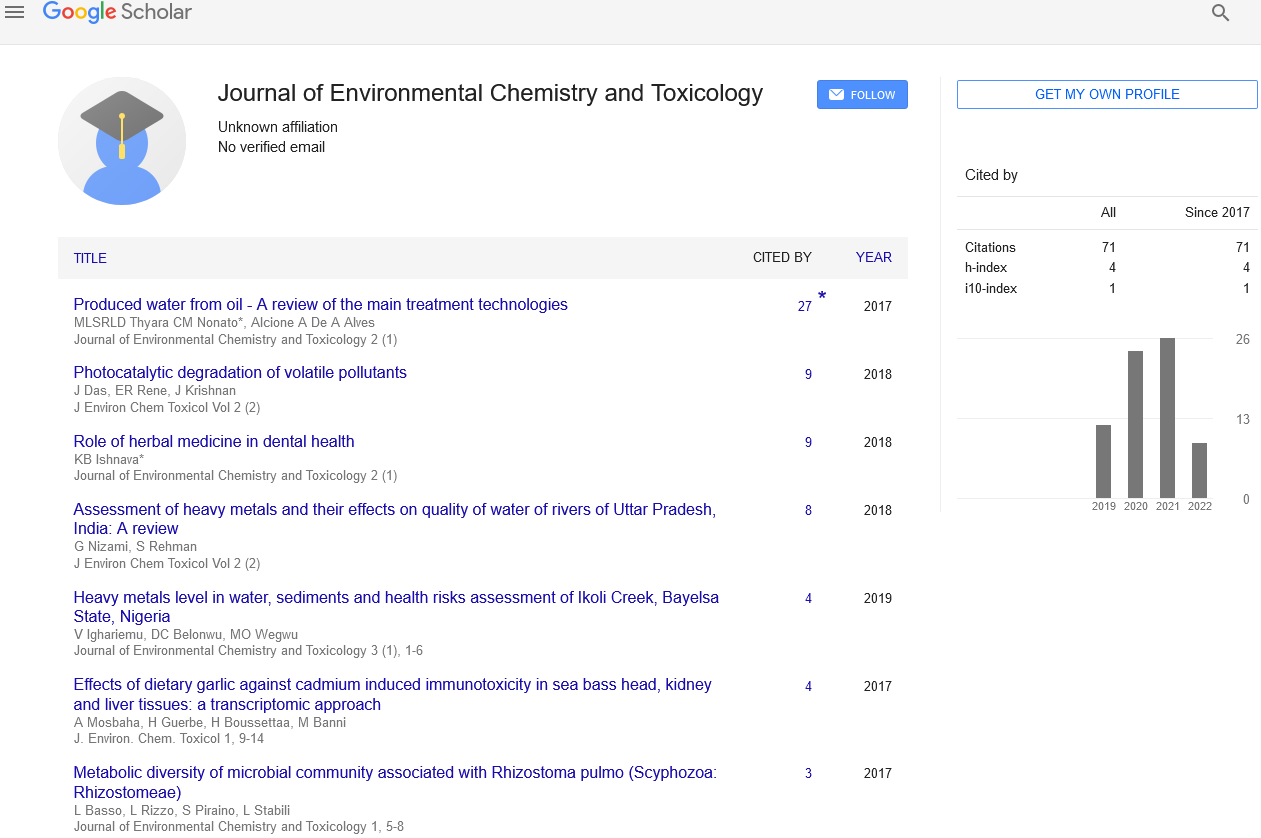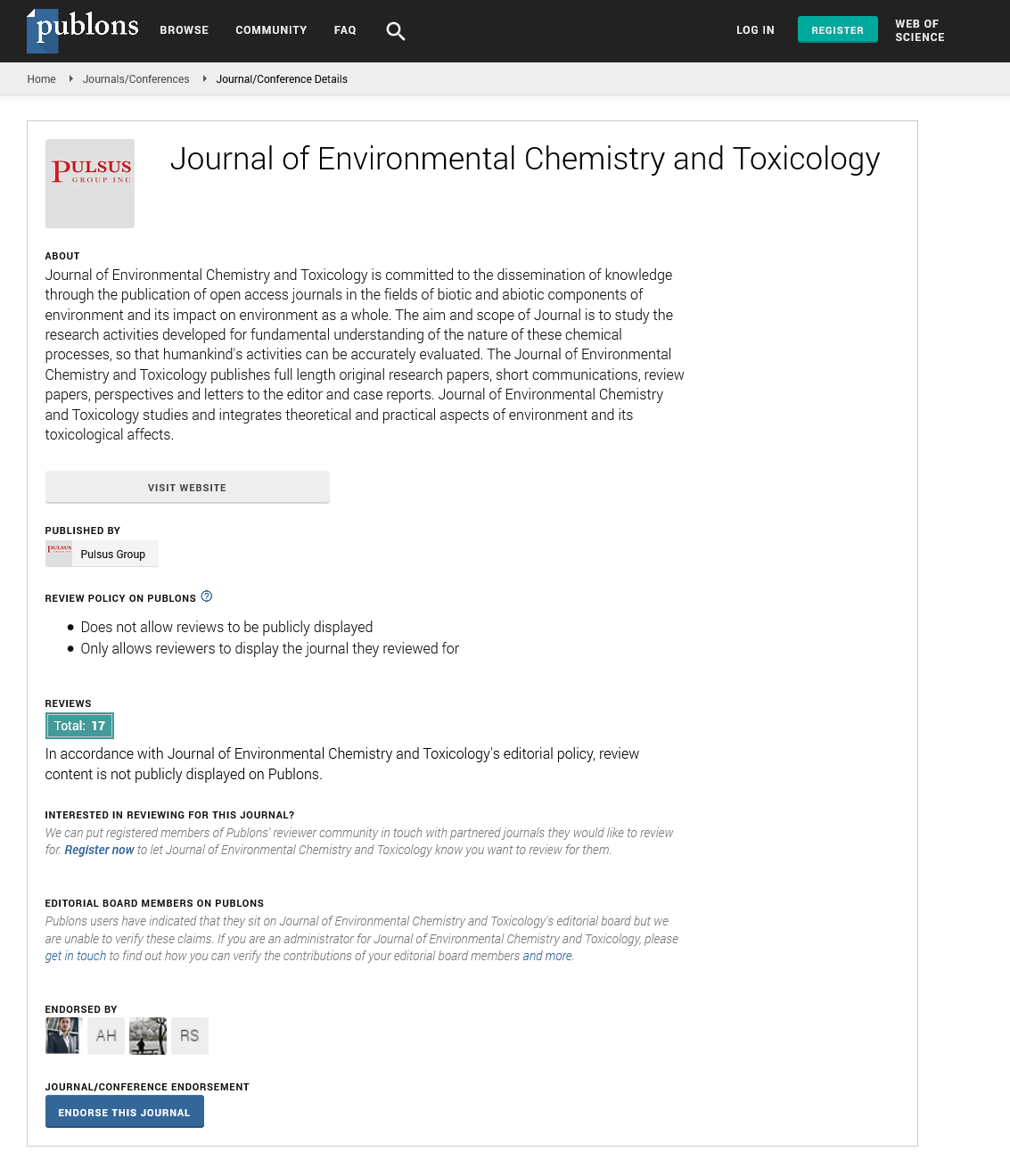Environmental cleanup using metallic iron
Received: 04-Jul-2022, Manuscript No. PULJECT-22-5204; Editor assigned: 12-Jul-2022, Pre QC No. PULJECT-22-5204(PQ); Accepted Date: Jul 18, 2022; Reviewed: 14-Jul-2022 QC No. PULJECT-22-5204(Q); Revised: 16-Jul-2022, Manuscript No. PULJECT-22-5204(R); Published: 24-Jul-2022, DOI: 10.37532/pulject.2022.6(4);01-02
Citation: Stewart J. Environmental cleanup using metallic iron. J Environ Chem Toxicol. 2022;6(4):01-02.
This open-access article is distributed under the terms of the Creative Commons Attribution Non-Commercial License (CC BY-NC) (http://creativecommons.org/licenses/by-nc/4.0/), which permits reuse, distribution and reproduction of the article, provided that the original work is properly cited and the reuse is restricted to noncommercial purposes. For commercial reuse, contact reprints@pulsus.com
Abstract
The suitability of remediation structures the use of metal iron (FeO) has been significantly mentioned all through the beyond three decades. It has been installed that aqueous FeO oxidative dissolution isn’t always due to the presence of any contaminant. Instead, the reductive transformation of contaminants is a outcome of FeO oxidation. Yet researchers are nonetheless preserving that electrons from the metallic frame are concerned withinside the system of contaminant reduction. According to the electron performance idea, electrons from FeO must be redistributed to:
• Contaminants of concern (COCs),
• Herbal lowering agents (e.g., H2 O, O2 ), and/or reducible cocontaminants (e.g. NO3 ). The electron performance is described because the fraction of electrons from FeO oxidation that’s applied for the reductive variations of COCs. This idea is in frontal contradiction with the view that FeO isn’t always without delay concerned withinside the system of contaminant reduction. This communique recollects the universality of the idea that reductive methods found in remediation FeO/H2 O structures are mediated through primary (e.g., FeII, H/H2 ) and secondary (e.g., Fe3 O4 , inexperienced rusts) merchandise of aqueous iron corrosion. The essential assessment of the electron performance idea shows that it must be abandoned. Instead, studies efforts must be directed toward tackling the actual demanding situations for the layout of sustainable FeO-primarily based totally water remedy structures primarily based totally on essential mechanisms of iron corrosion
Keywords
Dissolution; Contaminants
Introduction
Metallic iron (FeO), additionally termed as Zero-Valent Iron (ZVI) is broadly taken into consideration as a cost-powerful decreasing agent for natural pollution in groundwater. The FeO-primarily based totally Permeable Reactive Barrier (PRB) era for groundwater remediation is rooted in this premise. FeO has additionally been correctly used for the elimination of diverse inorganic contaminants (e.g. As, NO3 −) and pathogens (e.g., bacteria, viruses) from polluted waters. However, those packages are especially gave the impression to be derived from the FeO PRB era for natural pollution. The idea that FeO is an electron donor below environmental situations has in no way been experimentally established. For example, whilst investigating the reductive dechlorination of Carbon Tetrachloride (CT) in FeO/H2 O systems, surely verified that decreasing electrons aren’t from FeO, despite the fact that iron corrosion changed into beneficial for CT reductive dechlorination. Their conclusions examine as: “The inherent courting among the dechlorination of CT and the corrosion of iron is attributed to the reality that the adsorbed hydrogen atoms produced at some stage in the iron corrosion method are important for the dechlorination method of CT.” The concept that natural pollution are reductively converted through FeO changed into delivered with inside the clinical literature through. Scientists from the University of Waterloo (Canada) had been investigating the capacity for sampling bias because of sorption of chlorinated natural species to substances normally utilized in groundwater sampling. Their outcomes discovered losses of chlorinated natural contaminants from water samples in touch with FeO-primarily based totally vessels. Hence, reductive dechlorination changed into proposed because the maximum possibly response path. This statement coincided with a duration while geochemists had been searching out appropriate substances for the conclusion of the idea of groundwater remediation the use of PRBs as delivered with inside the Nineteen Eighties through. In different words, FeO changed into taken into consideration a decreasing agent (or an electron donor) for natural pollution, due to the fact their reductive transformation changed into located in its presence, with inside the FeO/H2 O system. This twist of fate changed into misinterpreted as a systematic truth and nonetheless prevails. Investigations were stated to verify those observations. Moreover, it changed into claimed that the statement that natural pollution may be decreased in FeO/H2 O structures changed into novel (frontally contradict the claimed novelty. In particular, with inside the paper entitled, “Feasibility assessment of a unique technique for destruction of organics”, tested that Cu2+ cementation through FeO may be used to result in the reductive degradation of natural pollution. Clearly, FeO is oxidized through Cu2+ and response products (FeII and H/ H2 species) act as decreasing marketers for the (natural) Contaminants Of Concern (COCs). In different words, Fe II species because of iron corrosion are used for the “destruction of organics.” Factually, H2 and H species additionally because of iron corrosion are decreasing marketers as tested. Aqueous iron corrosion is an electrochemical system which desires 4 booths to arise: an anode, a cathode, a conductor and an electrolyte. In the remediation FeO/H2O system, the conductor is the metallic body (FeO), the electrolyte is the polluted water, the anode is a place of the FeO floor in which oxidative dissolution takes place (freeing ferrous iron–Fe2+), and the cathode is a place of the FeO floor in which electrons left in the back of via way of means of Fe2+ are transferred to a reducible species. A key function of this system is that, the reactions on the anode and the cathode arise simultaneously, and the prerequisite is that the electrolyte should keep in touch with each the anode and the cathode. Aqueous iron corrosion proceeds as follows:
- FeO is oxidatively dissolved on the anode to launch Fe2+,
- the generated Fe2+ ions migrate with inside the polluted water (electrolyte), and iii) then electrons left in the back of via way of means of Fe2+ are transferred via the metallic body (conductor) to a reducible species on the cathode.
It is critical to underline that electrons are transported from the anode to the cathode via way of means of FeO. Electron switch to any adsorbed species handiest takes place if there may be no conduction barrier on the FeO floor. It is famous that, at pH>4.5, an oxide scale paperwork at the FeO floor and shields it from dissolved species, which include dissolved O2 . For the EE idea to be applicable, it manner that the popular oxide scale on FeO have to be electronically conductive, which isn’t the case in FeO/ H2O systems. Pathways of contaminant elimination and alterations in FeO/H2O systems. Aqueous iron corrosion is an electrochemical system which desires 4 booths to arise: an anode, a cathode, a conductor and an electrolyte. In the remediation FeO/H2O system, the conductor is the metallic body (FeO), the electrolyte is the polluted water, the anode is a place of the FeO floor in which oxidative dissolution takes place (freeing ferrous iron–Fe2+), and the cathode is a place of the FeO floor in whichelectrons left in the back of via way of means of Fe2+ are transferred to a reducible species. A key function of this system is that, the reactions on the anode and the cathode arise simultaneously, and the prerequisite is that the electrolyte should keep in touch with each the anode and the cathode. Aqueous iron corrosion proceeds as follows:
- FeO is oxidatively dissolved on the anode to launch Fe2+,
- The generated Fe2+ ions migrate with inside the polluted water (electrolyte), and
- Then electrons left in the back of via way of means of Fe2+ are transferred via the metallic body (conductor) to a reducible species on the cathode.
It is critical to underline that electrons are transported from the anode to the cathode via way of means of FeO. Electron switch to any adsorbed species handiest takes place if there may be no conduction barrier on the FeO floor. It is famous that, at pH>4.5, an oxide scale paperwork at the FeO floor and shields it from dissolved species, which include dissolved O2 . For the EE idea to be applicable, it manner that the popular oxide scale on FeO have to be electronically conductive, which isn’t the case in FeO/H2O. Pathways of contaminant elimination and alterations in FeO/H2O.






